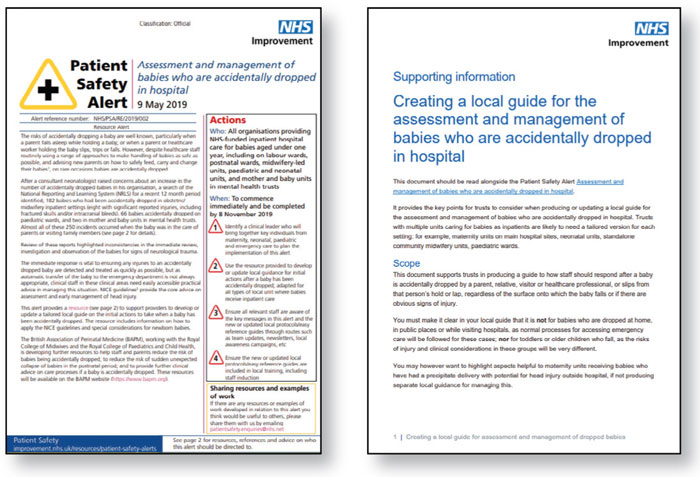Guidelines for the management of babies who are accidentally dropped in hospital: have these been developed in your service?
In May 2019 NHS Improvement published the patient safety alert Assessment and Management of Babies who are Accidentally Dropped in Hospital. The patient safety alert provided a resource to support organisations to develop or update a tailored local guide on the initial actions to take when a baby has been accidentally dropped, including information on how to apply NICE guidelines and special considerations for newborn babies. The actions outlined in the alert needed to be completed in November 2019 – do you have any concerns relating to the management of babies accidentally dropped at work or how your organisation has implemented the national patient safety alert?
Becky Wilson-CrellinPatient Safety Clinical Lead (Maternity and Neonates), NHS England and NHS Improvement
In May 2019 NHS Improvement published the patient safety alert Assessment and Management of Babies who are Accidentally Dropped in Hospital (FIGURE 1).1 The alert was initiated following concerns raised by a consultant neonatologist about an increase in the number of accidentally dropped babies in his organisation. A search of the National Reporting and Learning System (NRLS) for a recent 12 month period identified:
- 182 babies who had been accidentally dropped in obstetric/midwifery inpatient settings (eight with significant reported injuries, including fractured skulls and/or intracranial bleeds)
- 66 babies accidentally dropped on paediatric wards
- two babies accidentally dropped in mother and baby units in mental health trusts.
Almost all of these 250 incidents occurred when the baby was in the care of parents or visiting family members.
A review of these reports highlighted inconsistencies in the immediate review, investigation and observation of the babies for signs of neurological trauma. The immediate response is vital to ensuring any injuries to an accidentally dropped baby are detected and treated as quickly as possible, but as automatic transfer of the baby to the emergency department is not always appropriate, clinical staff in these clinical areas need easily accessible practical advice in managing this situation. National Institute for Health and Care Excellence (NICE) guidelines provide the core advice on assessment and early management of head injury.2
The alert provided a resource to support organisations to develop or update a tailored local guide on the initial actions to take when a baby has been accidentally dropped, including information on how to apply the NICE guidelines and special considerations for newborn babies (FIGURE 2). The actions outlined in the alert were for organisations to:
- identify a clinical lead to coordinate key individuals from all relevant specialties and plan the implementation of this alert
- develop or update local guidance
- ensure staff are aware of the new/updated guidance
- ensure the new/updated guidance is included in local training, including staff induction.

FIGURE 1 (above) Last year’s patient safety alert.
FIGURE 2 (above right) The resource for supporting providers to develop or update tailored local guides on the initial actions to take when a baby has been accidentally dropped.
These tailored local guides are vital as many staff working in maternity and neonatal services may only encounter the situation once in their working life. Planning ahead so that everything that might be needed, from where to care for the baby while observations are being carried out, how to order a CT scan, and what information the parents need once their baby can go home, has been thought through and clearly laid out for easy reference. The local guidelines will make a real difference to the speed and effectiveness of care.
The actions outlined in the alert needed to be completed by 8 November 2019, so ask yourself:
- are you aware of this patient safety alert?
- do you know if your organisation has developed or updated its local guideline relating to the management of babies who are accidently dropped in hospital?
- if it has, are you familiar with its content?
- does it help you to know what to do if a baby is accidently dropped while you are at work?
If you have any concerns relating to the management of babies accidentally dropped at work, or how your organisation has implemented the national patient safety alert, you should raise these concerns with your line manager.
In addition to the alert and its associated supporting resource, the British Association of Perinatal Medicine (BAPM), working with the Royal College of Midwives and the Royal College of Paediatrics and Child Health, is developing further resources to help staff and parents reduce the risk of babies being accidentally dropped. These will reduce the risk of sudden unexpected collapse of babies in the postnatal period and provide further clinical advice on care processes if a baby is accidentally dropped. These resources will be available on the BAPM website (www.bapm.org) in due course.
National patient safety alerts rely on organisations implementing and embedding the recommended actions to help mitigate against the identified patient safety issue from reoccurring. Failure to do this means that identified patient safety issues will remain. It is vital that clinicians talk openly about potential patient safety issues within their teams and wider networks. These conversations can help build a culture of safety within an organisation – let’s start the conversation today.
Or read this article in our
Tablet/iPad edition


